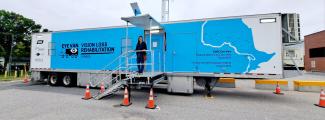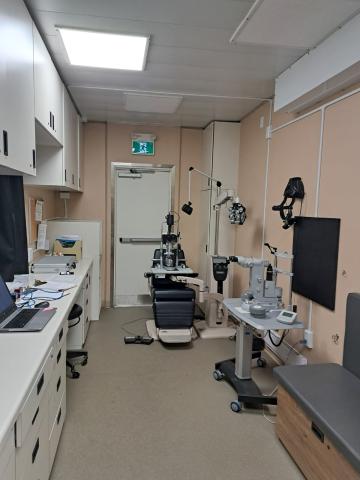
By: Natalie Mezey
Natalie Mezey, an MD Candidate at Queen's University, is an Affiliate Member of the Research Excellence Cluster in Vision. She had the opportunity to volunteer with the Vision Loss Rehabilitation Canada Eye Van, a fully equipped, mobile eye clinic that travels more than 6,000 kilometres annually to provide service to people in remote regions of Northern Ontario.
As a teenager, I spent a few summers volunteering for the Canadian National Institute for the Blind (CNIB) canvassing my neighbourhood for donations. I was somewhat shy, and the idea of knocking on someone’s door asking for money, was not an obvious activity for me. My idea of vision loss was my grandma reading her book with her giant magnifying glass. Otherwise, I knew nobody who suffered from significant vision loss, let alone blindness.

Yet the idea of losing one’s vision, something so fundamental to quality of life, was something I, even with my limited exposure, could appreciate had devastating impacts and was worthy of getting outside of my comfort zone. Since then, advocacy and even the occasional fundraising was a big part of my past personal and professional life. In medical school I have been involved in various health equity initiatives, including working on See the Path, a mentorship in medicine program for Indigenous youth and organizations such as Northern Vision that aims to increase understanding of and access to vision care in rural, remote and Indigenous Communities.
When I was offered an opportunity to volunteer with the Vision Loss and Rehabilitation Canada (VLRC) Eye Van, I jumped at the chance. My husband, toddler and I flew from Ottawa to Winnipeg and drove 5 hours from Winnipeg to beautiful Northwestern Ontario Treaty 3 territory to a small community where roughly 1/3 of the population is Indigenous. It really felt like the confluence of so many of my past and present interests and I really wanted to see first-hand how care was being delivered in communities without permanent specialists.
“My doctor doesn’t do eyes, but the van is coming!” – Patient of the Eye Van, 2023
The Eye Van is really a big rig which travels over 6,000 km providing care to approximately 5,000 patients in various remote, underserved communities in Northern Ontario. The list of communities varies from year to year but selected based on need and the availability of staff. Communities with fewer or no providers are prioritized. The Eye Van will stay in a town from two days to a couple of weeks at a time. Ophthalmologists are recruited from a list from all over Ontario and beyond, all willing to donate their time on the Eye Van. It is staffed with two ophthalmic technicians, an ophthalmologist and an enthusiastic driver who is himself trained in visual field assessment to maximize the efficiency of the operations. Patients are referred by an optometrist, nurse practitioner or family physician, or are follow-ups from the previous year and are each called personally by the Eye Van appointment coordinator. Many patients come with chronic presentations such as diabetes, glaucoma, as well as acute vision changes.
Remarkably, the Eye Van is well-equipped with everything from a slit lamp to a laser which performs posterior capsulotomy (YAG) and Selective Laser Trabeculoplasty (SLT) procedures. Small oculoplastic procedures can also be done. If the ophthalmologist notes the need for a YAG or SLT procedure, the patient would be offered to have it done then on the spot, often saving patients from a longer drive to a bigger center such as Winnipeg or Thunder Bay. The downstream benefits of this are tremendous. I heard patients say they were on a waitlist of many months and were extremely grateful that they had just been saved a long drive, time off work and additional travel costs. For many, the Eye Van is a rare encounter with a health care provider and in the past, staff have even caught a life-threatening emergency.
The Patient Experience
While I was there, I noted the long days of the hard-working staff. From 8am to often 5 or 6pm, staff were seeing patients, doing thorough visual field and acuity tests one by one. While some patients felt frustrated for having to wait in the small waiting room within the limited space inside the Eye Van, the overwhelming and recurring sentiment was gratitude. They described how their doctor warned them that they’d need more extensive eye care, that she “doesn’t do eyes” but that “the Van is coming!” Many patients thanked us for being there and I would hear statements like “my eyes are my life” and “my vision is everything.”
While I naturally wondered about the continuity of care for these patients for a service that is only available annually, I was pleased to see that the assessments and treatments were communicated with their referring health care provider and that detailed instructions were given for next steps and future follow-ups. Considerations for accessibility to future care and travel time also informed the care offered on the Eye Van. If a patient couldn’t realistically get a treatment needed in the next couple of months, if indicated, it would be offered there on the Eye Van. While the Eye Van might have only been in a community for a few days, there was significant thought given to what happens after it leaves. I was both impressed with how much can be done in a small space and the meaningful impact that a travelling van can have on patient care. The Eye Van was a welcome guest in the community. As one patient noted “we’re all millionaires when we have our vision!” I will forever be grateful to Vision Loss Rehabilitation Canada for having me and for the privilege of being part of this unique patient experience.